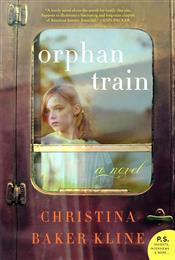
Review by Michelle Palmer
Molly Ayars has had her fair share of disappointment. After her father is killed in a car accident and her drug-abusing mother is arrested, she spends years being shuffled from one foster family to another. At age 17, Molly is about to age out of the foster care system and face charges for stealing a book from the school library when a friend recommends her for a community service project that might keep her out of jail. The project involves helping 91-year-old Vivian clean out her attic, and at first, the teenage Goth girl and the elderly widow seem to have little in common. But as Molly helps Vivian sort through boxes of memorabilia, they realize that they have more in common than they could have imagined.
Christina Baker Kline’s novel Orphan Train skillfully weaves the stories of present-day Molly with the tragic history of Vivian, who lost her family in the early 1920s. While Molly’s story of rejection and trying to find her way through the challenging foster care system is poignant, it is Vivian’s story that is most captivating. After losing her family in a New York City tenement housing fire, Vivian (then known by her Irish name, Niahm) is placed in a temporary orphanage. But before she can come to terms with her own grief, Niahm (pronounced Neeve) is placed on an “orphan train” with other children ranging from infants to teenagers. The train is headed for various cities in the Midwest, where an organization known as the Children’s Aid Society will help them find new homes. Much like Molly, Niahm only wants to find a family who will love her, but instead she is passed from one family to another, enduring cruelty, neglect and rejection.
Part of the book’s appeal is the history behind it. Between the years of 1854 and 1929, as many as 200,000 children of all ages boarded trains to the Midwest, most of them destined, like the book’s main character, for a life of servitude. Although ostensibly the program was designed to provide homes for orphaned or abandoned children, it also provided people in the Midwest with free labor. Those in the highest demand were babies and young men, and those hardest to place were adolescent girls, who, like Vivian, were seen as posing a threat to the wife of the household. Siblings were separated, and original birth certificates sealed. The sense of shame from those placed on the trains was so pervasive that most rarely spoke of it, and it wasn’t until the 1950s and beyond when train riders began to search for family members and other fellow orphans who shared the same experiences.
Orphan Train is a sweet and touching story of friendship, resilience and strength of character, but it is the glimpse into a little known part of American history that makes this novel an intriguing and thought-provoking read.













